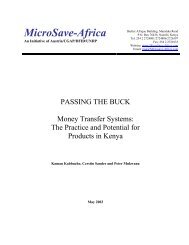You also want an ePaper? Increase the reach of your titles
YUMPU automatically turns print PDFs into web optimized ePapers that Google loves.
household word. USAID had commissioned <strong>DAI</strong><br />
and another firm to do a “stocktaking” <strong>of</strong> the<br />
many and various efforts to assist people owning<br />
and running very small businesses. Such<br />
businesses usually had only one or two employees<br />
and participated in the informal economy—<br />
that is, not licensed, not keeping books, and not<br />
paying taxes.<br />
For more than four months, Boomgard comanaged<br />
the microenterprise stocktaking with<br />
a brilliant economist from the other firm, but the<br />
study fell seriously behind schedule, and the<br />
USAID <strong>of</strong>ficers supervising the work became<br />
seriously worried. Barclay asked them to give<br />
Boomgard sole authority to complete the study,<br />
promising them that <strong>DAI</strong> would absorb any<br />
additional costs if it ran over budget, and assuring<br />
them that they would be fully satisfied<br />
with the final product. Boomgard delivered, and<br />
the guarantee was fulfilled. In the process, he<br />
became convinced that when the next multiyear<br />
microenterprise research and development<br />
opportunity came around, <strong>DAI</strong> could win the<br />
contract.<br />
One day late in 1988, Boomgard invited<br />
Mickelwait and Barclay to lunch and laid out<br />
his idea. It would require his full-time attention<br />
over several months and a significant proposal<br />
investment, and it was something <strong>of</strong> a gamble,<br />
since the economist’s firm had managed the<br />
predecessor contract. Nevertheless, he said, “I<br />
would like to have your blessing to establish <strong>DAI</strong><br />
as a leading player in this field.” Mickelwait and<br />
Barclay did not have to consider long. “Go for<br />
it,” they replied.<br />
The stocktaking report, which had been widely<br />
read, was certain to influence USAID’s RFP,<br />
because it highlighted areas where further “action<br />
research” should be undertaken. To prepare<br />
for it, Boomgard assembled a team in <strong>DAI</strong> and<br />
worked closely with experts from such institutions<br />
as ACCION International, which had been<br />
involved in Latin American microlending since<br />
the 1970s, and Michigan State University, where<br />
much <strong>of</strong> the leading academic work on small<br />
and micro enterprises was being done. The<br />
RFP for Growth and Equity through Microenterprise<br />
Investments and Institutions (GEMINI)<br />
looked much as Boomgard had expected. After<br />
Jim Boomgard<br />
(center) led <strong>DAI</strong>’s<br />
successful efforts<br />
in the field <strong>of</strong><br />
microenterprise<br />
development. Here<br />
he is shown with<br />
Maria Otero, then <strong>of</strong><br />
ACCION International,<br />
and Doug Salloum<br />
<strong>of</strong> the Calmeadow<br />
Foundation.<br />
47



